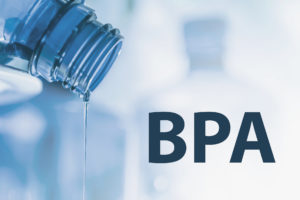You may have heard “endocrine disruptors” mentioned in association with certain cancers, like breast cancer. But do you know what they are and where they lurk in your food, home and personal care products? And do you know why it matters to your health?
Endocrine disruptors are industrial chemicals used in herbicides, pesticides, detergents, children’s toys, plastic bottles, metal food cans, flame retardent products and personal care products including cosmetics. (to name just a few examples). Endocrine disruptors can wreak havoc on your body’s endocrine system (e.g., hormones) and your long-term health. Endocrine disruptors are extremely risky for pregnant women and can cause damage to the developing fetus.
Here’s the scientific explanation from the National Institute of Environmental Health Sciences Source (link for further info)
Endocrine disruptors are chemicals that may interfere with the body’s endocrine system and produce adverse developmental, reproductive, neurological, and immune effects in both humans and wildlife. A wide range of substances, both natural and man-made, are thought to cause endocrine disruption, including pharmaceuticals, dioxin and dioxin-like compounds, polychlorinated biphenyls, DDT and other pesticides, and plasticizers such as bisphenol A. Research shows that endocrine disruptors may pose the greatest risk during prenatal and early postnatal development when organ and neural systems are forming.
The non-profit Environmental Working Group (www.ewg.org) is one of my favorite go-to resources for information on foods and personal care products that may contain harmful industrial chemicals to avoid. The EWG lists 12 endocrine disruptors on its wesbite. For the sake of space, I have shared five of them below. You can see the full list and tips on reducing your risk at at THIS LINK
BPA: This synthetic hormone is found in the linings of cans and plastics (like water bottles). According to the EWG, “BPA has been linked to everything from breast cancer and prostate cancer to reproductive problems, obesity, early puberty and heart disease, and according to government tests, 93 percent of Americans have BPA in their bodies!”
Tip: Go fresh! Not canned. Use “Bisphenol -BPA-free” water bottles.

Photo © Ivan Uralsky | Dreamstime.com
Phthalates: These are chemicals found in many household products from detergent to shampoo to plastic wrap and children’s toys (there is an ongoing effort to ban phthalates from toys). The EWG says “Phthalates have been linked to lower sperm count, less mobile sperm in the male reproductive system, birth defects, obesity, diabetes and thyroid irregularities.”
Tip: Try to avoid plastic products and products listed with “fragrance” which is where many phthalates may be hidden. Fragrance can be a skin irritant anyway.

Photo: © Polina Ryazantseva Dreamstime.com
Atrazine: This is an herbicide widely used on crops, like corn. Crop spraying can also lead to contaminated drinking water. Studies have linked Atrazine to breast tumors, prostate cancer and delayed puberty.
Tip: Buy organic produce. Avoid plastic. Use water filters.

© Charles Brutlag | Dreamstime.com
Mercury: Watch your sushi consumption. Mercury been found in many species of fish. It can affect the fetus in pregnant women, damage pancreatic cells which can affect your insulin, and put people with compromised autoimmune systems at risk.
Tip: Try to consume more sustainably sourced seafood. Check out the Monterrey Bay Aquarium’s Seafood Watch listing fish to eat, avoid and proceed with caution. The list is updated annually which is helpful since knowing when buying “wild” versus “farmed” fish can be confusing. I recommend downloading the free App. It’s available on both Apple and Google Play. LINK

Photo © Py2000 | Dreamstime.com
Glycol Ethers: These are commonly found in cleaning products, cosmetics,brake fluid and paints. They can affect a man’s sperm count, affect a fetus’ development and have been linked to asthma and allergies in children.
Tip: Look for this ingredient on labels. It may also be listed as 2-butoxyethanol (EGBE) and methoxydiglycol (DEGME).

Photo © Liv Friis-larsen | Dreamstime.com
Some final tips to selecting better products for your body or home:
Read up on what’s safe and what to avoid from a reliable source.
- Read labels on products before you purchase. The fewer ingredients, the better, especially if you can’t pronounce them
- Buy fresh and organic food whenever possible. But wash everything since we’ve all read reports about e-coli outbreaks. And, handle food with care.
- Buy fragrance-free products.
- Buy a water filter if you have questionable water supply but use it wisely and keep it clean and replace as directed.
The EWG provides these helpful links:
EWG Guide to Reducing BPA: www.ewg.org/bpa/
EWG’s Guide to Healthy Cleaning: www.ewg.org/guides/cleaners/
EWG Guide to pesticide/herbicide-free food: www.ewg.org/foodnews/
EWG Guide to buying water filters: www.ewg.org/report/ewgs-water-filter-buying-guide/
Here is the Monterrey Bay Aquarium Seafood Watch Website: http://www.seafoodwatch.org/
In summary: The more you know the more confident you will be about your health.

© Wanida Prapan | Dreamstime.com









